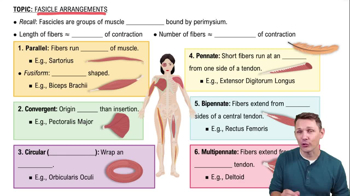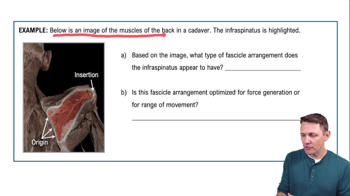Fascicle Arrangements definitions Flashcards
 Back
BackFascicle Arrangements definitions
1/15
Terms in this set (15)
- FascicleA group of muscle fibers bound together, running the entire length of a muscle without joining end to end.
- Parallel arrangementMuscle fibers run parallel to each other, allowing significant shortening but limited force due to fewer fibers.
- Fusiform arrangementSpindle-shaped muscle with fibers wider in the middle, allowing more force while maintaining a parallel arrangement.
- Convergent arrangementMuscle with a broad origin converging at a smaller insertion, enabling strong contraction with long fascicles.
- Circular arrangementMuscle fibers arranged in a circle, surrounding openings and contracting to close them, also known as a sphincter.
- Pennate arrangementFeather-like muscle fibers running at angles to a central tendon, allowing more fibers and greater force.
- UnipennateMuscle fibers run at an angle from one side of a tendon, allowing more force but shorter contraction lengths.
- BipennateMuscle fibers extend from both sides of a central tendon, allowing more force but shorter contraction lengths.
- MultipennateMuscle fibers extend from a branched tendon, allowing more force but shorter contraction lengths.
- SartoriusThe longest muscle in the body, with a parallel fascicle arrangement, allowing significant shortening.
- Biceps brachiiA fusiform muscle in the upper arm, spindle-shaped, allowing more force while maintaining a parallel arrangement.
- Pectoralis majorA convergent muscle of the chest with a broad origin and small insertion, enabling strong contraction.
- Orbicularis oculiA circular muscle surrounding the eye, contracting to close the eye opening.
- Extensor digitorum longusA unipennate muscle in the calf, with fibers running at an angle from one side of a tendon.
- Rectus femorisA bipennate muscle of the quadriceps, with fibers extending from both sides of a central tendon.


